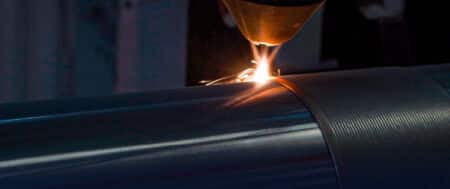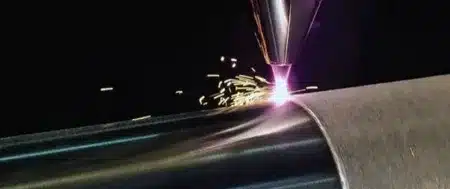Laser cladding technology is an advanced process where molten material is deposited onto the surface of a substrate to enhance the performance of components. Due to its significant advantages in improving wear resistance, corrosion resistance, and extending the service life of parts, laser cladding has been widely applied in various industries such as aerospace, automotive manufacturing, and petrochemicals. However, the quality of laser cladding is influenced by multiple factors, and only by thoroughly controlling these factors can the optimal performance of the cladding layer be ensured. This article delves into the key factors affecting the quality of laser cladding and provides corresponding optimization strategies.
1. Laser Power
Laser power is one of the most critical factors determining the quality of the cladding layer. The power level directly affects the temperature of the melt pool and the extent to which the cladding material melts.
Low Power: If the laser power is too low, the cladding material may not fully melt, leading to insufficient bonding between the cladding layer and the substrate, resulting in defects such as porosity or lack of fusion.
High Power: Conversely, if the laser power is too high, the substrate may excessively melt, causing uneven thickness in the cladding layer and potentially leading to cracks or increased thermal deformation of the substrate.
Optimization Strategy: Select the appropriate laser power based on the material properties and cladding layer requirements, ensuring that the melt pool has enough energy to achieve high-quality cladding while avoiding excessive heating of the substrate.
2. Scanning Speed
Scanning speed determines the movement speed of the laser beam across the substrate surface, and it, along with laser power, influences the temperature distribution of the melt pool and the thickness of the cladding layer.
High Scanning Speed: A higher scanning speed can result in a short contact time between the laser and the powder, causing the powder to fly away from the melt pool, reducing the temperature of the melt pool and resulting in a thinner cladding layer with potential incomplete melting.
Low Scanning Speed: A lower scanning speed may cause excessive melt pool temperature, increasing the heat-affected zone and potentially leading to thermal deformation of the substrate and cracking of the cladding layer.
Optimization Strategy: Adjust the scanning speed according to the laser power and characteristics of the cladding material to ensure uniformity of the cladding layer and stability of the melt pool, avoiding issues such as overheating or uneven cooling.
3. Powder Feed Rate
Powder feed rate refers to the speed at which cladding material is fed into the melt pool, directly affecting the thickness and quality of the cladding layer.
High Powder Feed Rate: If the feed rate is too high, excess material may not fully melt, leading to unmelted particles or porosity within the cladding layer.
Low Powder Feed Rate: A low feed rate may result in insufficient thickness of the cladding layer, failing to effectively improve the surface performance of the part.
Optimization Strategy: Adjust the powder feed rate based on the melt pool temperature and cladding layer requirements, ensuring that the material can fully melt and be evenly distributed to form a dense cladding layer.
4. Spot Size
The laser spot size directly influences the energy density of the laser beam. The smaller the spot size, the higher the energy density, and the higher the melt pool temperature.
Small Spot: Suitable for precise cladding processes but prone to causing localized overheating, leading to cracks in the cladding layer.
Large Spot: Can effectively reduce localized heat input and thermal stress, but may result in insufficient energy at the edges of the cladding layer, affecting the cladding effect.
Optimization Strategy: Choose the appropriate spot size based on the size and precision requirements of the cladding area to ensure uniformity and overall performance of the cladding layer.
5. Substrate Surface Condition
The cleanliness, roughness, and physical condition of the substrate surface directly impact the quality of the cladding layer.
Contaminants: If the substrate surface has oil stains, oxidation layers, or other contaminants, it may hinder the metallurgical bonding between the cladding material and the substrate, leading to insufficient bonding strength and porosity formation.
Surface Roughness: An excessively smooth or rough surface can affect the uniformity and bonding strength of the cladding layer.
Optimization Strategy: Perform appropriate pretreatment on the substrate surface before cladding, such as cleaning, grinding, or sandblasting, to enhance surface adhesion and improve the quality of the cladding layer.
6. Shielding Gas
Shielding gas (such as argon or nitrogen) is used during the laser cladding process to protect the melt pool from oxidation and other adverse reactions.
Insufficient Gas Flow: May expose the melt pool to air, causing oxidation, porosity, or cracking issues.
Excessive Gas Flow: May disrupt the stability of the melt pool, causing the powder to fly away from the melt pool, affecting the uniformity of the cladding layer.
Optimization Strategy: Choose the appropriate type and flow rate of shielding gas to ensure effective protection of the melt pool and its surrounding environment, preventing oxidation and other adverse reactions.
7. Cladding Material Selection
The chemical composition, particle shape, and size of the cladding material have a significant impact on the performance of the cladding layer.
Incompatible Materials: If there are significant differences in physical properties such as melting point, thermal expansion coefficient, elastic modulus, and thermal conductivity between the cladding material and the substrate, it may lead to cracking or poor bonding strength in the cladding layer.
Uneven Particle Distribution: Inconsistency in particle shape and size can affect the density, uniformity, and efficiency of the cladding layer.
Optimization Strategy: Select suitable cladding materials based on specific applications, ensuring that the chemical composition and particle shape of the material meet the process requirements for optimal cladding results.
8. Cooling Rate
The cooling rate affects the grain structure and residual stress of the cladding layer.
Rapid Cooling: May lead to the formation of thermal stress concentration zones in the cladding layer, causing cracks.
Slow Cooling: May result in coarse grains, reducing the mechanical properties of the cladding layer.
Optimization Strategy: Control the cooling rate according to the material characteristics and process requirements. Preheating or slow cooling methods can be employed if necessary to reduce cracks and stress concentration.
9. Inter-layer Pass Control
In multilayer cladding, the control of inter-layer passes directly affects the bonding strength and overall quality of the cladding layer.
Improper Control: May result in poor inter-layer bonding strength, even leading to delamination or cracks.
Excessive Time Between Passes: Can cause excessive cooling of the previous layer, affecting bonding with the next layer.
Optimization Strategy: Properly schedule the time between inter-layer passes and adjust process parameters to ensure good bonding between layers and enhance the overall performance of the cladding layer.
10. Laser Mode Selection
The laser mode (such as continuous wave or pulsed laser) also has a significant impact on the formation of the cladding layer.
Continuous Wave Laser: Suitable for uniform cladding with stable energy distribution, but may not be ideal for heat-sensitive materials.
Pulsed Laser: Suitable for precise localized cladding but requires precise control to avoid localized overheating.
Optimization Strategy: Select the appropriate laser mode based on cladding needs to ensure that the cladding layer quality meets expectations.
Conclusion
Numerous factors influence the quality of laser cladding, and only by comprehensively controlling these key parameters can high-quality cladding be achieved. In practical operations, it is necessary to optimize and adjust according to specific process requirements and material characteristics to ensure that the cladding layer achieves the best performance in terms of wear resistance, corrosion resistance, and bonding strength. In the future, as laser technology continues to advance, the laser cladding process will further improve, providing superior solutions for manufacturing and repair in various industries.







